Hydrodynamic Performance and Motion Response of a Novel Deep-Water TLP Floating Offshore Wind Turbine
Abstract
1. Introduction
2. Structural Scheme
2.1. Characteristics of TLP
2.2. Wind Turbine Model
2.3. The Mooring System
3. Methods
3.1. Hydrodynamic Loads
3.2. Mooring Systems Restoring Loads
3.3. Aerodynamic Loads
3.4. Equation of Motion
3.5. Numerical Model and Validation
4. Results and Discussion
4.1. Operating Conditions Setup
4.2. Free Decay Test
4.3. Raos Calculation
4.4. Motion Response Analysis
4.5. Tendon Tension Analysis
5. Conclusions
- (1)
- The innovative truss-type architecture of the TLP enhances both safety and ease of fabrication. Its hexagonal configuration significantly improves self-stability, which is particularly advantageous during transport and installation operations. Furthermore, this design effectively mitigates stress concentrations and improves the platform’s overall hydrodynamic performance.
- (2)
- The frequency-domain analysis reveals the platform’s excellent hydrodynamic response characteristics. Moreover, free-decay simulations show that the natural periods in surge (25.72 s), heave (1.47 s), and pitch (2.17 s) are well outside the typical wave-frequency range, in full compliance with DNV design codes.
- (3)
- Time-domain analysis confirms the platform’s robust stability under extreme sea states. In the most severe load case (LC6), maximum motion amplitudes were recorded as 11.19 m (surge), 0.86 m (heave), and 0.28 degrees (pitch), demonstrating excellent station-keeping and rotational stability. This superior stability was further investigated using the CWT, which proved essential for capturing the non-stationary dynamics and transient peak loads that are critical for reliable fatigue sizing.
- (4)
- The analysis of the mooring system shows that the maximum tension in the most loaded tendon reached 6.82 MN. This corresponds to less than 22% of the tendon’s MBL, providing the first quantitative confirmation of the engineering feasibility and safety of deploying this innovative FOWT design in extreme sea conditions like the South China Sea.
Author Contributions
Funding
Data Availability Statement
Conflicts of Interest
References
- Martynowicz, P.; Ślimak, P.; Katsaounis, G.M. TLP-Supported NREL 5MW Floating Offshore Wind Turbine Tower Vibration Reduction Under Aligned and Misaligned Wind-Wave Excitations. Energies 2025, 18, 2092. [Google Scholar] [CrossRef]
- Tian, Z.; Shi, W.; Li, X.; Park, Y.; Jiang, Z.; Wu, J. Numerical Simulations of Floating Offshore Wind Turbines with Shared Mooring under Current-Only Conditions. Renew. Energy 2025, 238, 121918. [Google Scholar] [CrossRef]
- Shen, M.; Hu, Z.; Liu, G. Dynamic Response and Viscous Effect Analysis of a TLP-Type Floating Wind Turbine Using a Coupled Aero-Hydro-Mooring Dynamic Code. Renew. Energy 2016, 99, 800–812. [Google Scholar] [CrossRef]
- Edwards, E.C.; Holcombe, A.; Brown, S.; Ransley, E.; Hann, M.; Greaves, D. Evolution of Floating Offshore Wind Platforms: A Review of at-Sea Devices. Renew. Sustain. Energy Rev. 2023, 183, 113416. [Google Scholar] [CrossRef]
- Provence Grand Large|Prysmian. Available online: https://www.prysmian.com/en/insight/projects/provence-grand-large (accessed on 8 August 2025).
- Home, DeepCWind. Available online: https://www.deepcwindco.com/ (accessed on 7 August 2025).
- Home. Available online: https://www.bluewater.com/ (accessed on 7 August 2025).
- MODEC. Available online: https://www.modec.com/ (accessed on 7 August 2025).
- PelaStar|The Premier Platform for Floating Offshore Wind. Available online: https://pelastar.com/ (accessed on 7 August 2025).
- GICON-Gruppe|Ingenieurdienstleister—www.gicon.de/DE. Available online: https://www.gicon.de/ (accessed on 7 August 2025).
- Jia, Z.; Wu, H.; Chen, H.; Li, W.; Li, X.; Lian, J.; He, S.; Zhang, X.; Zhao, Q. Hydrodynamic Response and Tension Leg Failure Performance Analysis of Floating Offshore Wind Turbine with Inclined Tension Legs. Energies 2022, 15, 8584. [Google Scholar] [CrossRef]
- Jiang, Z. Mooring Design for Floating Wind Turbines: A Review. Renew. Sustain. Energy Rev. 2025, 212, 115231. [Google Scholar] [CrossRef]
- Ma, Z.; Wang, S.; Wang, Y.; Ren, N.; Zhai, G. Experimental and Numerical Study on the Multi-Body Coupling Dynamic Response of a Novel Serbuoys-TLP Wind Turbine. Ocean. Eng. 2019, 192, 106570. [Google Scholar] [CrossRef]
- Jonkman, J.; Prowell, I.; Robertson, A.; Goupee, A.J.; Stewart, G.M. Numerical Prediction of Experimentally Observed Behavior of a Scale-Model of an Offshore Wind Turbine Supported by a Tension-Leg Platform. In Proceedings of the 2013 Offshore Technology Conference, Houston, TX, USA, 6–9 May 2013; p. OTC-24233-MS. [Google Scholar]
- Vita, L.; Ramachandran, G.K.V.; Krieger, A.; Kvittem, M.I.; Merino, D.; Cross-Whiter, J.; Ackers, B.B. Comparison of Numerical Models and Verification Against Experimental Data, Using Pelastar TLP Concept. In Proceedings of the OMAE2015, Volume 9: Ocean Renewable Energy, St. John’s, NL, Canada, 31 May–5 June 2015. [Google Scholar]
- Hmedi, M.; Uzunoglu, E.; Medina-Manuel, A.; Mas-Soler, J.; Vittori, F.; Pires, O.; Azcona, J.; Souto-Iglesias, A.; Guedes Soares, C. Experimental Analysis of CENTEC-TLP Self-Stable Platform with a 10 MW Turbine. J. Mar. Sci. Eng. 2022, 10, 1910. [Google Scholar] [CrossRef]
- Zhao, Y.; She, X.; He, Y.; Yang, J.; Peng, T.; Kou, Y. Experimental Study on New Multi-Column Tension-Leg-Type Floating Wind Turbine. China Ocean. Eng. 2018, 32, 123–131. [Google Scholar] [CrossRef]
- Zhang, Z.; Wang, X.; Zhang, X.; Zhou, C.; Wang, X. Dynamic Responses and Mooring Line Failure Analysis of the Fully Submersible Platform for Floating Wind Turbine under Typhoon. Eng. Struct. 2024, 301, 117334. [Google Scholar] [CrossRef]
- Guillaume, B.; Christian, B.; Christine, B.; Cecile, M.; Timothee, P.; Yann, P. Design and Performance of a TLP Type Floating Support Structure for a 6MW Offshore Wind Turbine. In Proceedings of the Offshore Technology Conference, Houston, TX, USA, 6 May 2019; p. D031S033R005. [Google Scholar]
- Wang, Y.; Yao, T.; Zhao, Y.; Jiang, Z. Review of Tension Leg Platform Floating Wind Turbines: Concepts, Design Methods, and Future Development Trends. Ocean. Eng. 2025, 324, 120587. [Google Scholar] [CrossRef]
- Lefebvre, S.; Collu, M. Preliminary Design of a Floating Support Structure for a 5MW Offshore Wind Turbine. Ocean. Eng. 2012, 40, 15–26. [Google Scholar] [CrossRef]
- Shen, M.; Hu, Z.; Geng, T. Coupled Hydrodynamic and Aerodynamic Response Analysis of a Tension-Leg Platform Floating Wind Turbine. J. Ship Mech. 2017, 21, 263–274. [Google Scholar]
- Nejad, A.R.; Bachynski, E.E.; Kvittem, M.I.; Luan, C.; Gao, Z.; Moan, T. Stochastic Dynamic Load Effect and Fatigue Damage Analysis of Drivetrains in Land-Based and TLP, Spar and Semi-Submersible Floating Wind Turbines. Mar. Struct. 2015, 42, 137–153. [Google Scholar] [CrossRef]
- Xue, Y.; Wang, J.; Zhao, W.; Wan, D. Numerical Analysis of Effects of Wind-Wave-Current Interactions on the Performance of Floating Offshore Wind Turbine. In Proceedings of the 35th International Ocean and Polar Engineering Conference, Seoul, Republic of Korea, 1–6 June 2025. [Google Scholar]
- Wei, D.; Yuan, L.; Ji, X.; Wang, N.; Wang, L.; Liu, X. Dynamic Response and Power Generation of Floating Offshore Wind Farms under Different Wave Conditions Using an Efficient Evaluation Method. Phys. Fluids 2025, 37, 073334. [Google Scholar] [CrossRef]
- Ren, Y.; Shi, W.; Venugopal, V.; Zhang, L.; Li, X. Experimental Study of Tendon Failure Analysis for a TLP Floating Offshore Wind Turbine. Appl. Energy 2024, 358, 122633. [Google Scholar] [CrossRef]
- Rony, J.S.; Karmakar, D. Hydrodynamic Response Analysis of a Hybrid TLP and Heaving-Buoy Wave Energy Converter with PTO Damping. Renew. Energy 2024, 226, 120380. [Google Scholar] [CrossRef]
- Jonkman, J.; Butterfield, S.; Musial, W.; Scott, G. Definition of a 5-MW Reference Wind Turbine for Offshore System Development; NREL/TP-500-38060; NREL: Golden, CO, USA, 2009; p. 947422. [Google Scholar]
- Barros, P.; Lillestøl, D.-B.; Østby, E.; Olsen, J.H.; Yttervik, R. Review of Available Material on Usability and Suitability of High Strength Mooring Chain. In Proceedings of the 33rd International Ocean and Polar Engineering Conference, Ottawa, ON, Canada, 19–23 June 2023. [Google Scholar]
- Ansys Help. Available online: https://ansyshelp.ansys.com/public/account/secured?returnurl=/Views/Secured/main_page.html?lang=en (accessed on 17 October 2025).
- Faltinsen, O. Sea Loads on Ships and Offshore Structures; Cambridge University Press: Cambridge, UK, 1993; ISBN 978-0-521-45870-2. [Google Scholar]
- Moriarty, P.J.; Hansen, A.C. AeroDyn Theory Manual; National Renewable Energy Lab.: Golden, CO, USA, 2004. [Google Scholar]
- Ding, Q.; Li, C.; Yu, N.; Hao, W.; Ji, J. Numerical and Experimental Investigation into the Dynamic Response of a Floating Wind Turbine Spar Array Platform. J. Mech. Sci. Technol. 2018, 32, 1106–1116. [Google Scholar] [CrossRef]
- Yue, M.; Liu, Q.; Li, C.; Ding, Q.; Cheng, S.; Zhu, H. Effects of Heave Plate on Dynamic Response of Floating Wind Turbine Spar Platform under the Coupling Effect of Wind and Wave. Ocean. Eng. 2020, 201, 107103. [Google Scholar] [CrossRef]
- DNV-RP-C205 Environmental Conditions and Environmental Loads. Available online: https://www.dnv.com/energy/standards-guidelines/dnv-rp-c205-environmental-conditions-and-environmental-loads/ (accessed on 11 September 2025).
- CCS. Guideline for Certification of Offshore Wind Turbines. 2021. Available online: https://www.ccs.org.cn/ccswz/articleDetail?id=202110201078111112 (accessed on 11 September 2025).
- Yu, W.; Ding, Q.; Li, C.; Ye, Z. Time-Domain and Mooring Intensity Analysis of Motion Response of Tension Leg Platform of Floating Wind Turbines under Multiple Operating Conditions. J. Eng. Therm. Energy Power 2018, 33, 119–127. [Google Scholar] [CrossRef]
- Ren, Y.; Venugopal, V.; Shi, W. Dynamic Analysis of a Multi-Column TLP Floating Offshore Wind Turbine with Tendon Failure Scenarios. Ocean. Eng. 2022, 245, 110472. [Google Scholar] [CrossRef]
- Wang, X.; Zhang, Z.; Zhuge, P. Transient Analysis of a Novel Full Submersible Floating Offshore Wind Turbine with CFRP Tendons. Ocean. Eng. 2022, 266, 112686. [Google Scholar] [CrossRef]
- DNV GL. DNVGL-ST-0119 Floating Wind Turbine Structures. DNV GL. 2021. Available online: https://www.dnv.com/energy/standards-guidelines/dnv-st-0119-floating-wind-turbine-structures/#:~:text=This%20DNV%20standard%20%28ST%29%20specifies%20general%20principles%20and,the%20structural%20design%20of%20floating%20wind%20turbine%20structures (accessed on 11 September 2025).
- DNV-RP-0286-Coupled Analysis of Floa Ting Wind Turbines. Available online: https://www.dnv.com/energy/standards-guidelines/dnv-rp-0286-coupled-analysis-of-floating-wind-turbines/#:~:text=Get%20a%20preview%20of%20DNV-RP-0286%20here%20%28PDF%29%20This,be%20used%20in%20combination%20with%20the%20referenced%20standards (accessed on 11 September 2025).

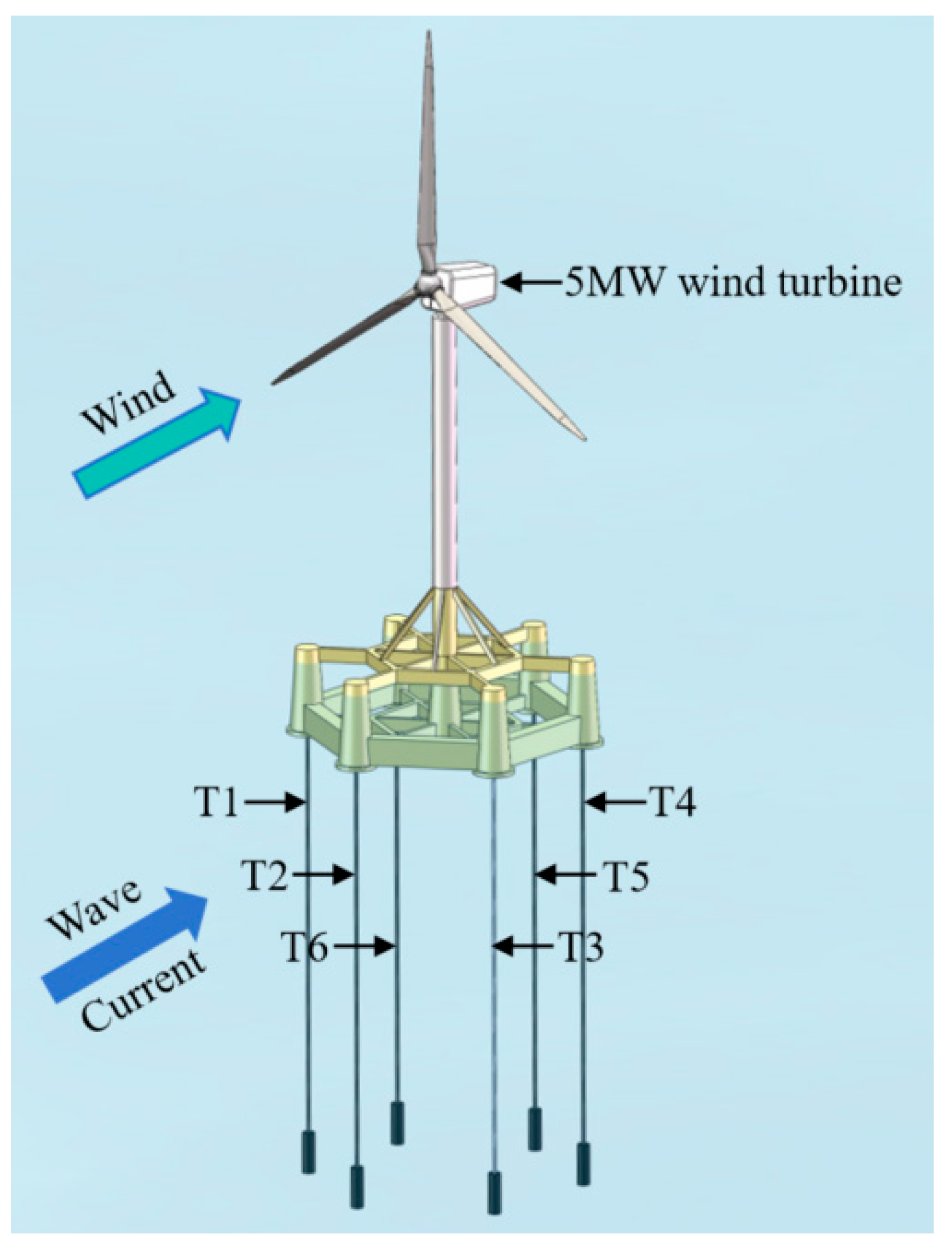
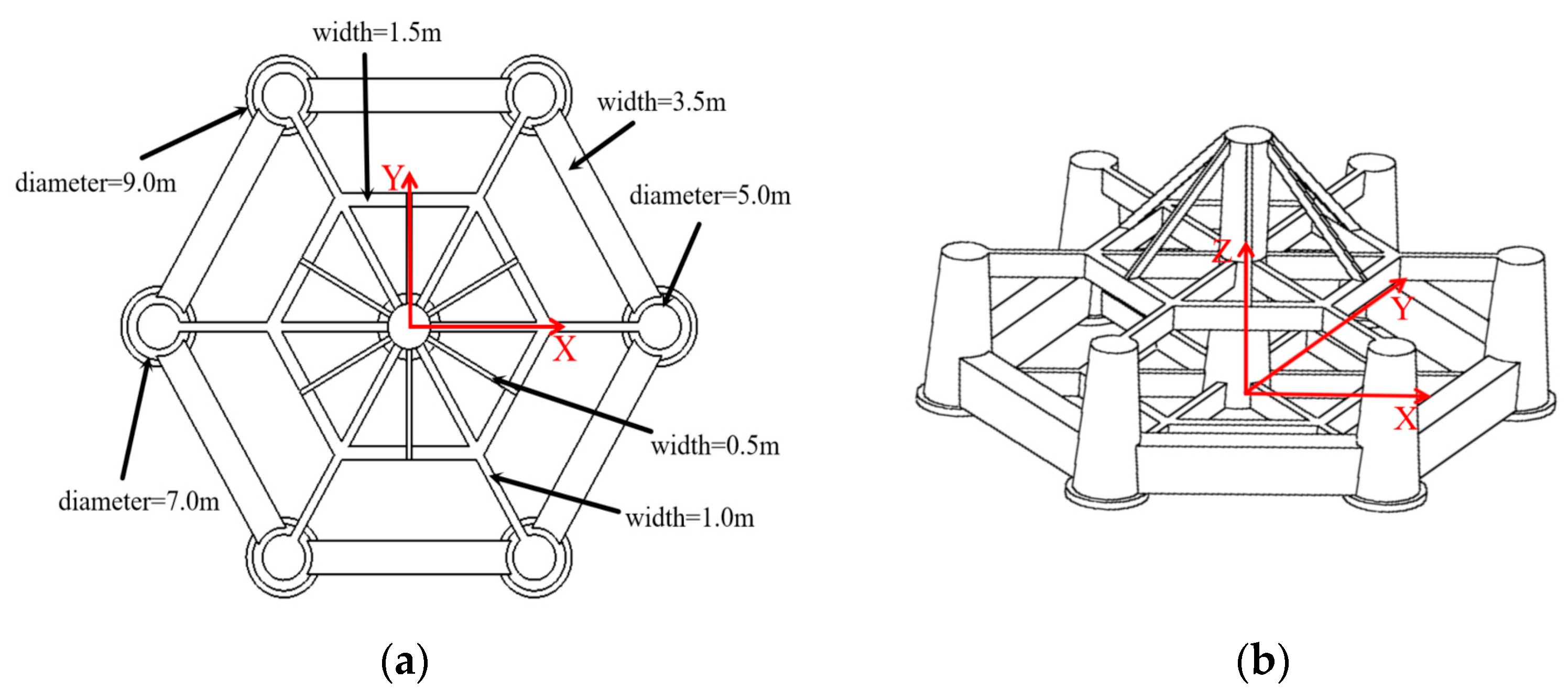

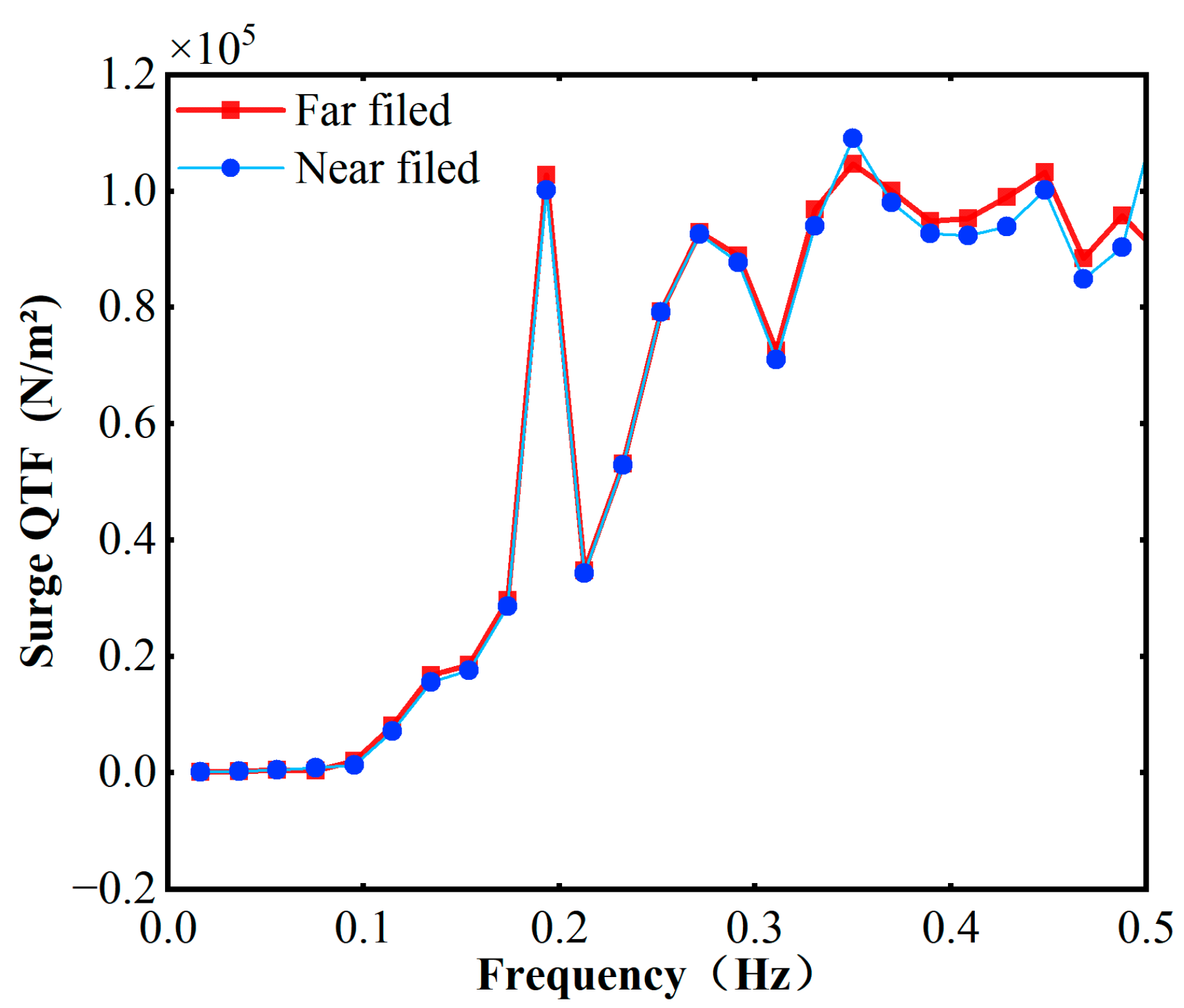
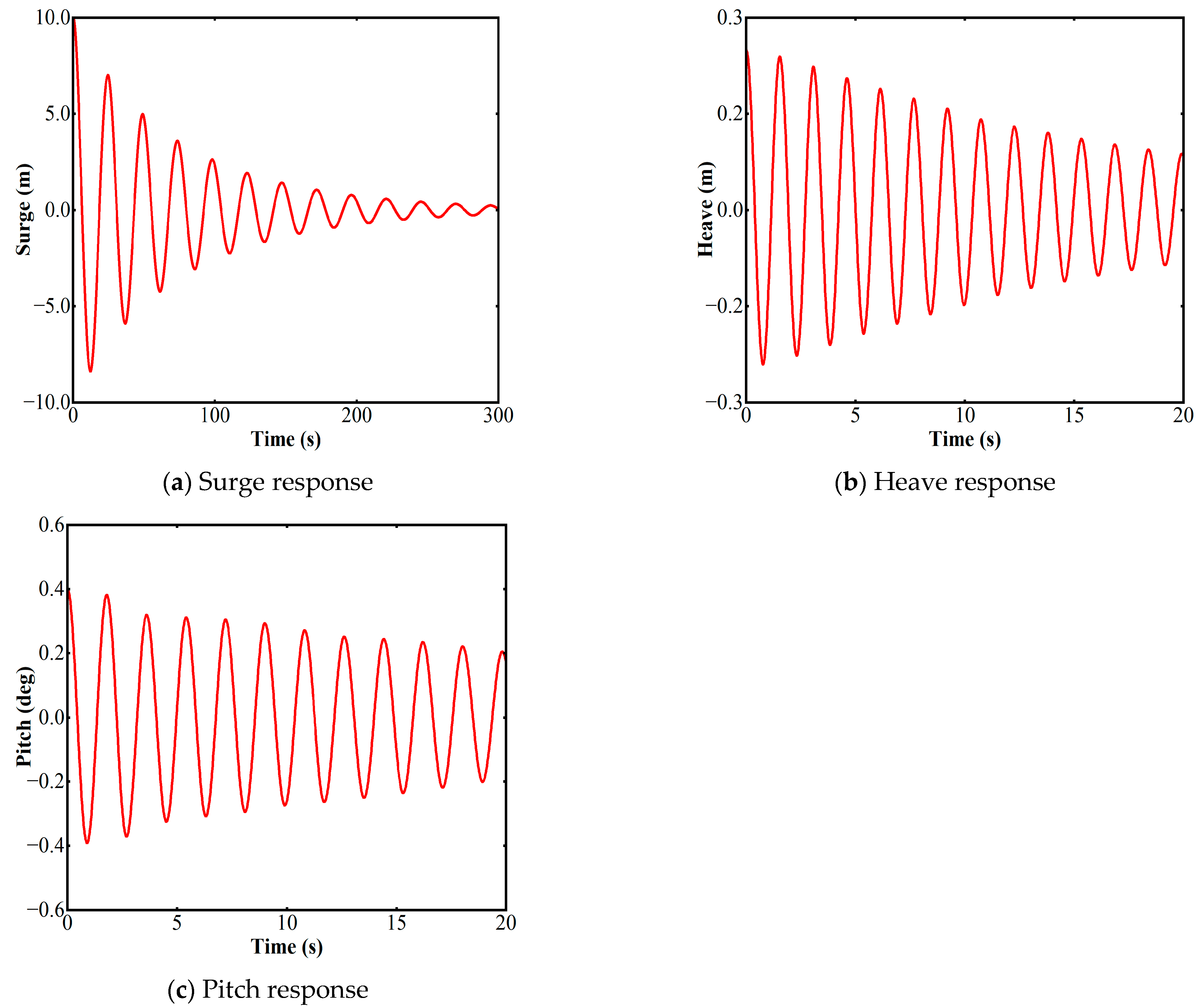


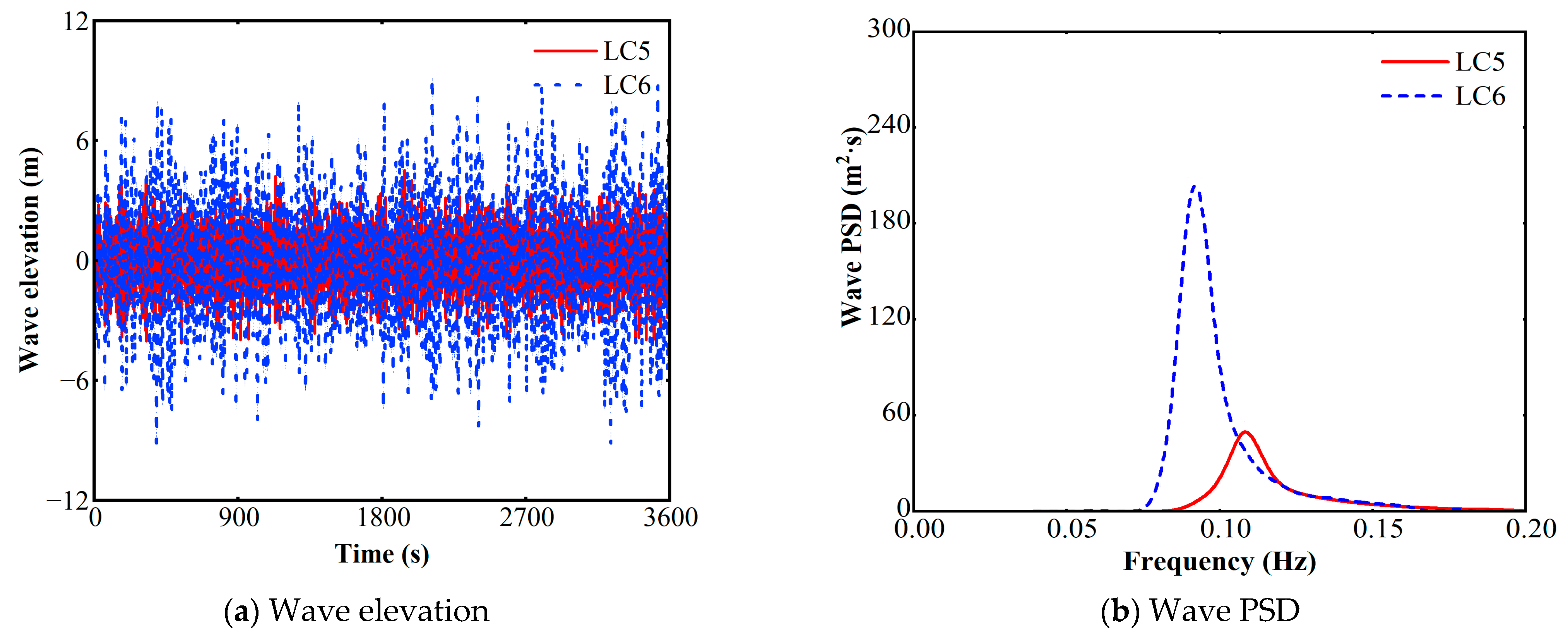





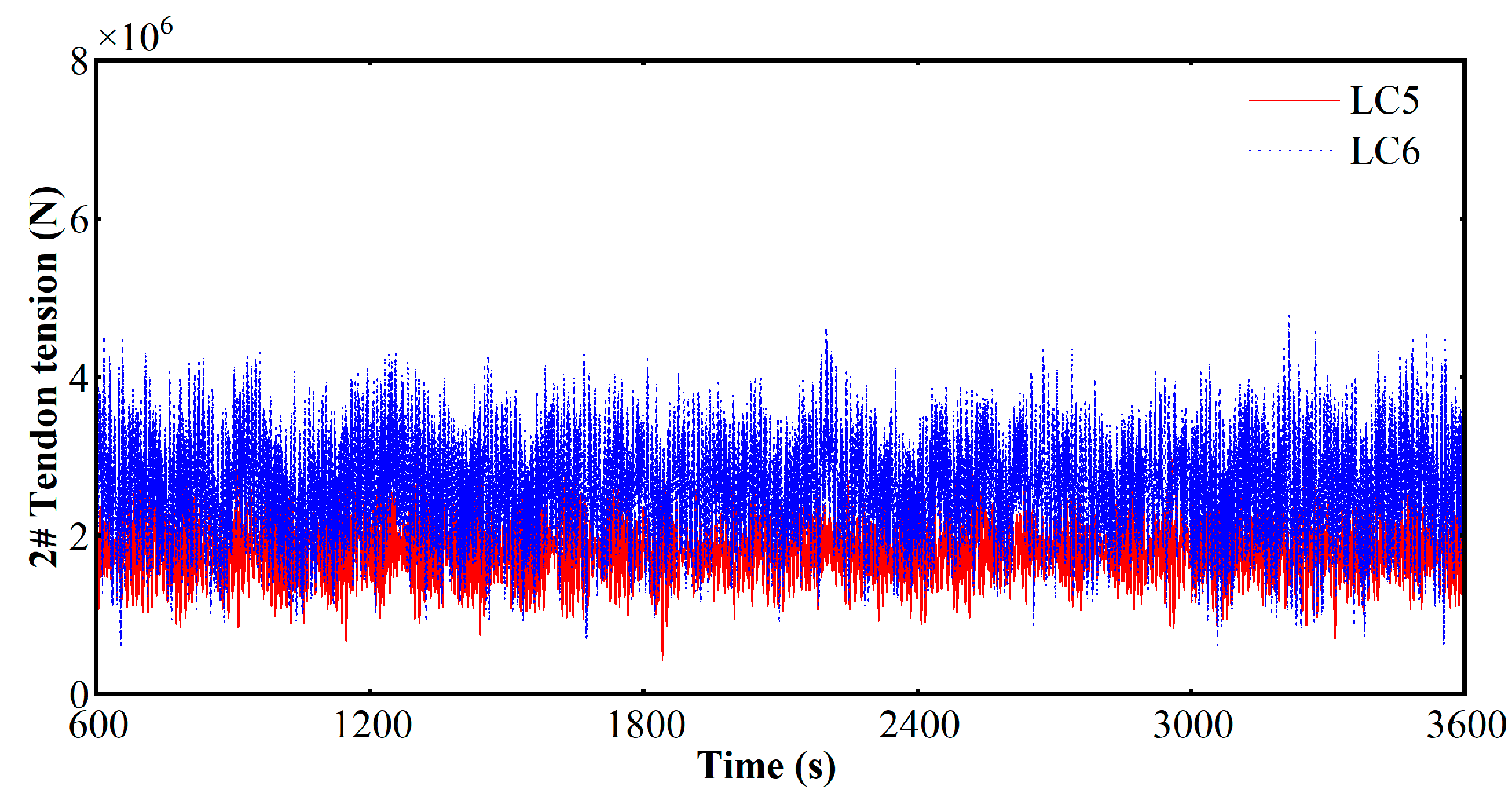

| Parameters | Value |
|---|---|
| Central column diameter at the top | 5.0 m |
| Central column diameter at the bottom | 7.0 m |
| Side column diameter at the top | 5.0 m |
| Side column diameter at the bottom | 7.0 m |
| Side column height | 18.0 m |
| Heave plate diameter | 9.0 m |
| Heave plate height | 1.0 m |
| Distance between tower and side column centerline | 30.0 m |
| Water depth | 100.0 m |
| Platform mass | 4820.0 tone |
| Design draft | 14.5 m |
| Displacement | 4699.0 m3 |
| Parameters | Value |
|---|---|
| Rating | 5 MW |
| Tower Mass | 347,460 kg |
| Rotor Mass | 110,000 kg |
| Nacelle Mass | 240,000 kg |
| Hub Height | 90 m |
| Rotor, Hub Diameter | 126 m, 3 m |
| Rotor Orientation | Upwind |
| Cut-In, Rotor, Cut-Out Wind Speed | 3 m/s, 11.4 m/s, 25 m/s |
| Cut-In, Rated Rotor Speed | 6.9 rpm, 12.1 rpm |
| Coordinate Location of Overall CM | (−0.2 m, 0.0 m, 64.0 m) |
| Number of Tendons | Tendon Diameter | Mass Density in Air | Axial Stiffness | Total Pretension |
|---|---|---|---|---|
| 6 | 245 mm | 386.67 kg/m | 1.58 × 109 N | 6396 KN |
| Tendon Number | Upper Attachment Point | Lower Attachment Point |
|---|---|---|
| T1 | (30.0, 0.0, −14.5) | (30.0, 0.0, −100.0) |
| T2 | (15.0, 26.00, −14.5) | (15.0, 26.00, −100.0) |
| T3 | (−15.0, 26.0, −14.5) | (−15.0, 26.00, −100.0) |
| T4 | (−30.0, 0.0, −14.5) | (−30.0, 0.0, −100.0) |
| T5 | (−15.0, −26.00, −14.5) | (−15.0, −26.00, −100.0) |
| T6 | (15.0, −26.00, −14.5) | (15.0, −26.00, −100.0) |
| Conditions | Wind Load | Wave Load | Current Load | ||
|---|---|---|---|---|---|
| Model | |||||
| LC1 | - | - | 3.0 m | 8.7 s | - |
| LC2 | - | - | 5.6 m | 10.3 s | - |
| LC3 | - | - | 7.8 m | 12.5 s | - |
| LC4 | - | - | 11.4 m | 14.9 s | - |
| LC5 | NPD | 11.4 m/s | 7.8 m | 12.5 s | 1.0 m/s |
| LC6 | NPD | 25.0 m/s | 11.4 m | 14.9 s | 1.5 m/s |
| Degree of Freedom | [38] | FSP [39] | Present Study | DNV Standard [40] |
|---|---|---|---|---|
| Surge (s) | 18.62 | 34.36 | 25.72 | 15~60 |
| Heave (s) | 1.54 | 2.10 | 1.47 | 1~2 |
| Pitch (s) | 2.32 | 1.52 | 2.17 | 2~5 |
| Load Case | Item | T1 | T2 | T3 | T4 | T5 | T6 |
|---|---|---|---|---|---|---|---|
| LC5 | MEAN (MN) | 2.11 | 1.82 | 1.25 | 1.01 | 1.25 | 1.82 |
| STD (MN) | 0.46 | 0.30 | 0.27 | 0.33 | 0.27 | 0.29 | |
| MAX (MN) | 3.77 | 3.01 | 2.12 | 2.23 | 2.08 | 2.86 | |
| LC6 | MEAN (MN) | 3.50 | 2.62 | 1.94 | 1.18 | 1.93 | 2.63 |
| STD (MN) | 0.99 | 0.57 | 0.43 | 0.51 | 0.42 | 0.57 | |
| MAX (MN) | 6.82 | 4.65 | 2.39 | 2.51 | 2.49 | 4.40 |
Disclaimer/Publisher’s Note: The statements, opinions and data contained in all publications are solely those of the individual author(s) and contributor(s) and not of MDPI and/or the editor(s). MDPI and/or the editor(s) disclaim responsibility for any injury to people or property resulting from any ideas, methods, instructions or products referred to in the content. |
© 2025 by the authors. Licensee MDPI, Basel, Switzerland. This article is an open access article distributed under the terms and conditions of the Creative Commons Attribution (CC BY) license (https://creativecommons.org/licenses/by/4.0/).
Share and Cite
Zhu, R.; Lai, Z.; Li, C.; Qian, H.; Yuan, H.; Xie, Y.; Sun, K. Hydrodynamic Performance and Motion Response of a Novel Deep-Water TLP Floating Offshore Wind Turbine. J. Mar. Sci. Eng. 2025, 13, 2131. https://doi.org/10.3390/jmse13112131
Zhu R, Lai Z, Li C, Qian H, Yuan H, Xie Y, Sun K. Hydrodynamic Performance and Motion Response of a Novel Deep-Water TLP Floating Offshore Wind Turbine. Journal of Marine Science and Engineering. 2025; 13(11):2131. https://doi.org/10.3390/jmse13112131
Chicago/Turabian StyleZhu, Ronghua, Zongyuan Lai, Chunlong Li, Haiping Qian, Huaqi Yuan, Yingchun Xie, and Ke Sun. 2025. "Hydrodynamic Performance and Motion Response of a Novel Deep-Water TLP Floating Offshore Wind Turbine" Journal of Marine Science and Engineering 13, no. 11: 2131. https://doi.org/10.3390/jmse13112131
APA StyleZhu, R., Lai, Z., Li, C., Qian, H., Yuan, H., Xie, Y., & Sun, K. (2025). Hydrodynamic Performance and Motion Response of a Novel Deep-Water TLP Floating Offshore Wind Turbine. Journal of Marine Science and Engineering, 13(11), 2131. https://doi.org/10.3390/jmse13112131








_Zhu.png)


